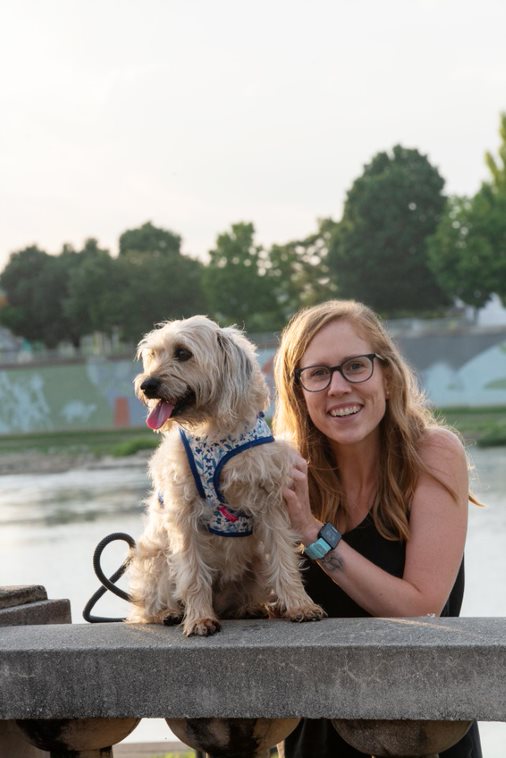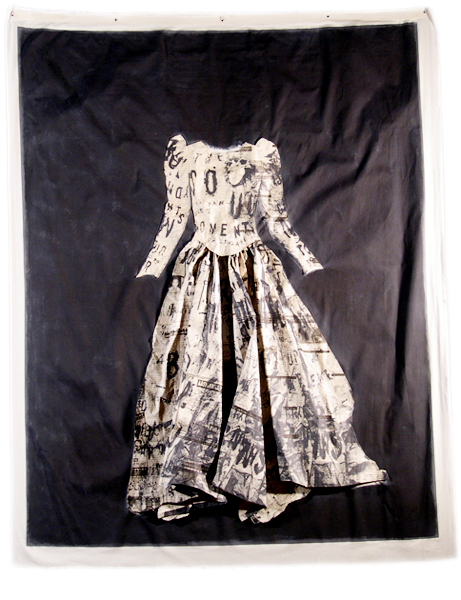This interview is the start of a new monthly blog post where student and KMA intern Tristen Luken is reaching out to people who have had previous experiences at the Kennedy Museum of Art at the Ridges. Some of the interviewees used to work at the museum while others just visited. The goal is to see how their experiences here served them in their future and to see where they are now. We also want to use this to connect people during this time of separation.
For our first interview we will be talking to Ohio University Alumna and previous Kennedy Museum student employee Meghan Dillon. This interview is particularly special because Meghan was Tristen’s high school art teacher and a big influence on who she is today!

First, please introduce yourself and give us some background information on who you are and what you do.
I’m Meghan Dillon and I’m an artist, educator, and perpetual graduate student based in Dayton, Ohio. I worked at the Kennedy Museum during undergrad and after receiving my BFA from Ohio University moved to Cincinnati, where I worked at the Cincinnati Art Museum. I left the museum world in 2009 and began teaching in public schools, where I’m now in my 12th year teaching art. In that time, I’ve earned my MAT and am currently working on a second graduate degree in Educational Leadership. I’m active in service and professional organizations locally and around the state. Outside of my professional life, I’m an avid baker, runner, dog mom, and enthusiastic downtown dweller. I make art daily as part of my job, but find it’s a lot harder to force myself to create resolved personal pieces because I create all day long. I’m definitely a maker though!
If you are an artist, how would you describe your creative process? Alternatively, how would you describe your professional activities.
My creative process and my professional activities are so much a part of who I am, so they’re kind of hard to deconstruct as their own things. Post college I definitely learned I’m not big on creating things for others to consume, but I love creating. I took myself off of all social media a couple of years ago and found it had a profound impact on the work I was creating. I wasn’t creating work because I had to put it out on Instagram, I wasn’t creating work because I was trying to get into a show, I wasn’t creating work to keep myself afloat by selling it on Etsy. I started creating work that I was genuinely interested in creating, which was really freeing. In that same time frame, I went through some pretty big life changes including losing my mom, who was only 56, and I realized I didn’t care if anybody praised the work I was creating. It made me happy just to MAKE. That thread runs through a lot of what I do – I keep a tiny urban garden, I cook a lot, I sew simple clothes, two of the bowls sitting on my kitchen table right now are objects I made. None of that work is groundbreaking or going to get me into a gallery anytime soon, but it’s satisfying for me to create and that’s worth it. For that reason it’s usually a pretty small group of folks who see the personal work I create. I share work regularly with a tight group of friends or sometimes students see projects I’m working on out at school, but I definitely create work for myself.

How has COVID-19 impacted your creative process, career, or education?
Not to make light of the situation this has brought on anyone, but my creative process has been positively impacted by COVID-19. I suddenly no longer have to feel guilty about retreating to my house, dragging out whatever project I’m working on, and spending days or weeks avoiding friends so I can keep working. It’s now suddenly made me a good citizen by doing so! I tend to be a really independent person who thrives on alone time, so now all my favorite restaurants deliver, I have a great reason to stay home and keep others safe, and I’m spending more time making art since probably college! As for my education, it has been all over the place. I was enrolled in in-person classes when we very quickly were shut down in the spring and now it’s split. One class I’m taking is in person and one is online. I don’t think the delivery of the course matters as much as the person facilitating it. I feel far more satisfied by my online class right now because I feel a genuine connection with my instructor and my classmates. Even though we’re face-to-face for hours each week in my in-person class, it feels infinitely less engaging, so I almost wish it was online – at least that way I could be at home with my dog!
In terms of my career, it has been all over the place and seems to change almost hourly. We went from in-person to fully remote overnight. I naively told students it would only last a couple of weeks, tops. I then informed them we would close out the school year that way – them at home, me recording dozens of videos a week, trying to teach studio classes to students with no supplies. This semester has been SO much better. I was able to get supplies to all of my students and we’re teaching synchronously, so I’m teaching a lot of what I normally would teach, but just a lot more thoughtfully. As we’re preparing to transition back to all students being in the building, I’ve learned more as an educator in the last 6 months than I normally would in 6 years in my field and I’m excited for that change in my teaching.
Who or what inspires you?
Patterns. Mid-Century design. Medical illustration. Design. Music. Cities. Craft and functional objects. Human resiliency and the power to decide what you will do with the life you’re given.
What experiences have you had with the Kennedy Museum of Art?
As absolutely cheesy as it sounds, Kennedy was so much more than a college job for me. It showed me what I wanted my career path to be. It showed me how to write grants, design educational materials, install a gallery. It showed me how to develop a passion about issues I care about and educate my community about them. It showed me how to be an advocate and make sure all students, no matter their background or experience, have a right to experience the world. Professionally it helped me understand so much better what I want out of my classroom when I became a teacher. Art products are great, but art experiences are even better.
I make trips back to Athens pretty regularly even now and just seeing the front steps of the building feels like home. My grandmother grew up in a small coal mining town in West Virginia and after her dad passed the family was forced to move to the “city” so her mom could find a job – Athens. Her mother was employed in Nelson dining hall and my grandma went through her high school years in Athens. She always had wonderful stories about going uptown to see a movie or walking the grounds of the now-Kennedy Museum. I loved hearing those stories about how this specific place had meant so much to the community for generations and yet it still evolves. And it’s still impacting the community all the same – just the ‘how’ is a little different. I think that understanding and appreciation of place really came from the Kennedy for me as I spent time researching how much the grounds changed over time as thinking around mental health advanced, until it eventually became something totally different to the Athens community, but still just as valuable.

Artwork photos courtesy of Meghan Dillon 
Artwork photos courtesy of Meghan Dillon
What role do you believe an academic museum like the Kennedy plays in a community like Athens? How do you think the community benefits from the museum?
I think they’re invaluable. My experience at the Kennedy was the first time I had any understanding at all that museums were places I could work and even more importantly places I could connect the local culture of whatever place I was with a greater worldview, specifically through art and cultural objects in this case. I walked into the Kennedy having no clue what museum education was and walked out years later being an advocate for how important learning from objects is and the value it has to help create understanding about humanity. Sally Delgado was so influential on my thinking about students and what they’re capable of learning and accomplishing, no matter what world they come from, and I hope I still bring that with me every day to my classroom. In Athens I encountered students who had never been out of the immediate geographical area, but they could immediately be transported anywhere because of a world-class collection right in their backyard. That value can’t be praised enough.
Is there a piece or artifact in the Kennedy’s collection that is your favorite? Why?
I really hope the Kennedy actually owned this piece, because it’s hands down Print Tapestries’ Poem Wedding Dress by Lesley Dill. I have adored that piece since the first time I saw it. My love of printmaking, written word as texture and imagery, the tactile-ness of it, the connection to domestic life, and overall the role traditional expectations play in gender politics and ideas around marriage. I LOVE IT. A close second and third are a lot of the silver and turquoise Zuni jewelry pieces and the fetish carvings.

To learn more about the Kennedy Art Museum please check out our virtual portal at https://www.ohio.edu/museum. Here you can check out our collection and current exhibitions. To check out other blog posts go to https://kennedymuseum.blog. Finally, feel free to follow us on Instagram at @KennedyMuseumArtEdu or Twitter at @KennedyMuseum. We also have a Facebook page titled Kennedy Museum of Art Experiences Group.

You must be logged in to post a comment.